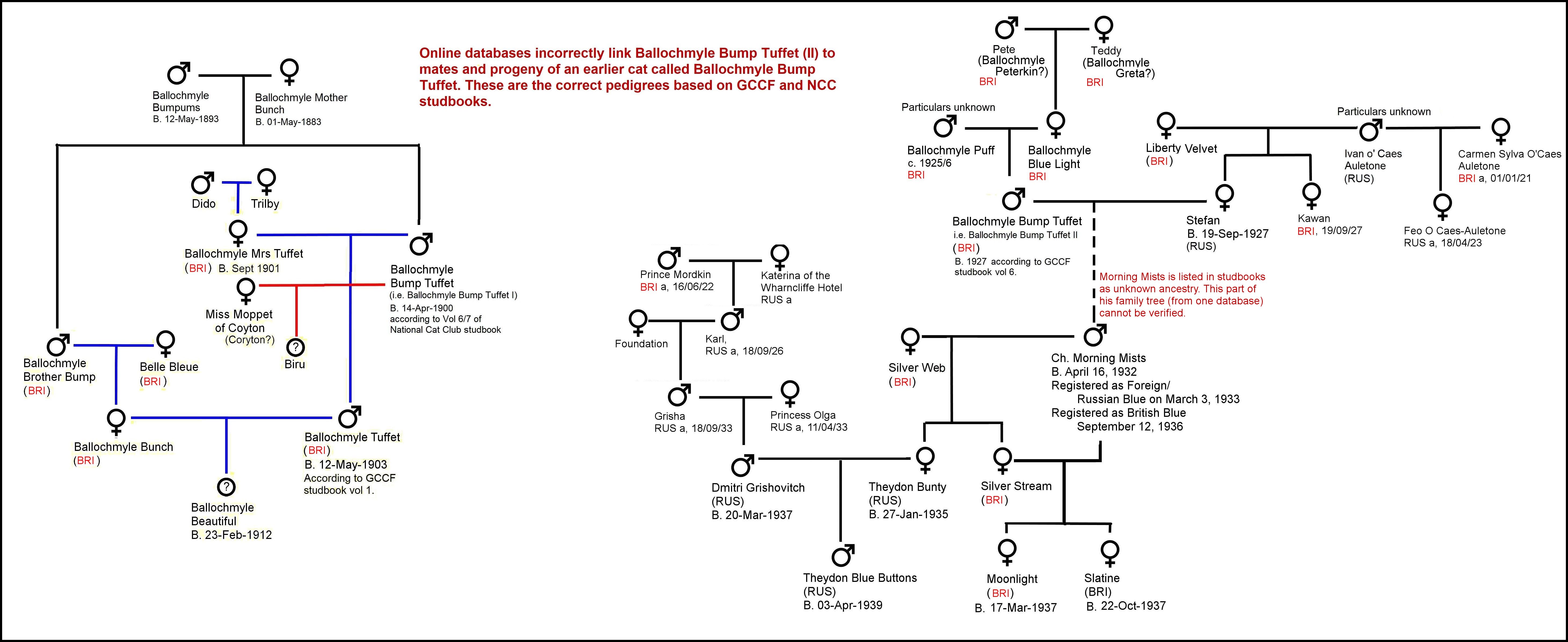
CATS AND CAT CARE RETROSPECTIVE: 1900s - 1930s: BREEDS AND VARIETIES: RUSSIAN BLUE
This article is part of a series looking about cats and cat care in Britain from the late 1800s through to the 1970s. It is interesting to note how attitudes have changed, as well as how our knowledge has increased.
The Russian Blue was an early fancy breed, supposedly brought to England from Archangel in the 1860s and initially exhibited as "Archangel Cats". Various shorthaired cats from Russia, and blue cats that did not meet the British Blue standard, ended up in the mix. Early imported foundation cats included solid blues, solid whites, lavender-blues, blue-and-whites, blue tabbies and solid blue "Siamese" (i.e. Korats). Some imported Russian Blues had long, lean pointed heads and large ears, while others had rounder heads, small ears and wide-set eyes. The coat could be short, close, glossy and silvery but others were rather woolly. They were bred to Black British Shorthairs to "improve" fur colour. The early cats were crossed with Persians to get a deep orange eye colour instead of green eyes, but at the expense of conformation and longhaired "sports." It was distinguished from British Blues by its more foreign appearance: larger ears and eyes, longer heads and legs and bright glossy fur. Up until 1912, they often competed in a general class for "Blue, With or Without White". For example, in 1896, a (solid) Blue Siamese was transferred from the Siamese class (on account of not being seal-pointed) into the "Russian or Any Other Blue Cat" class. The longer, leaner, leggier Russian Blue was judged against the British Blue standard, which it could not hope to meet. Dedicated Russian Blue breeders protested and in 1912 it was given its own class under the name "Foreign Blue".
The confusion of how to classify "Blue, With or Without White" cats is demonstrated by Champion "Morning Mists" who was initially bred as a Foreign/Russian Blue in the 1930s, but transferred to the British Blue breed after a few years. Most sources show him a unknown ancestry. One database shows his sire as Ballochmyle Bump Tuffet, a British Blue, and his dam as Stefan; this fits the timeline, but cannot be verified. Ballochmyle Bump Tuffet was actually the second cat with that name, which causes confusion in databases.

This Russian, named Champion Morning Mists, was born on April 16, 1932 in England. He was an intact male and was registered as Foreign/Russian Blue on March 3, 1933, as follows: "Morning Mists, male, Mrs. Bolton, - April 1932, further details unknown." (Source: Fur & Feather Magazine Courtesy of Elisabeth Stark)
In December 1933, this male was exhibited at a National Cat Club show. He received the following rating there:"Blue Foreign, 1 Mrs. Bolton, Ch. Morning Mists. Nice even color. I would like to see his head a bit more wedge-shaped and his eyes a little greener, but he should still be able to improve the breed as a stud." - Judge: Miss Wilson
On September 12, 1936, Morning Mists changed breed. From that time on, he was considered a British Blue Shorthair. This seems very strange to us, but apparently this happened quite often at that time. At cat shows, Morning Mists did just as well as a British Blue as he did when he competed as a Russian. Also as a Britishn he became champion and won several titles at shows.

Another blue that was registered as both Russian Blue and British Shorthair was Krimski (Krimsky) of Coryton, born 01-March-1936 (sire unknown, dam Suma).
During the Second World War, it was hard to maintain purebred lines in Britain. Numbers declined and it was impossible to transport cats over long distances to be mated. Some British breeders crossed their Russian Blues to the Siamese in order to preserve the conformation at the cost of introducing the recessive gene for colourpoints and the Siamese "voice" into the Russian Blue. Others crossed it to the British Blue to preserve the colour. The registration policy allowed outcrosses to unregistered cats of unknown parentage to re-invigorate the breed. The original conformation had to be restored through careful breeding.
Scandinavian breeders crossed their Russian Blues to Siamese and to blue cats from Finland, preserving both the short coat and the green eyes. The Russian Blue arrived in the USA in the early 1900s, but serious breeding did not begin until after the Second World War. American breeders used stock from Scandinavia and Britain and worked to eliminate any Siamese traits. As a result, the American Russian Blue differs from those in Britain, Europe and Australasia.